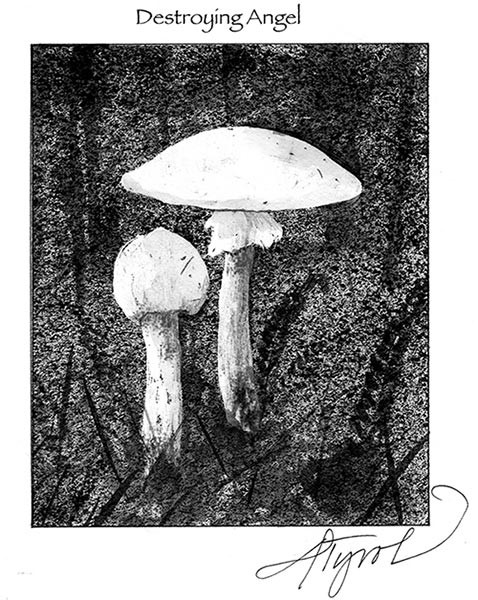
One of our big collective cultural fears about nature involves poisonous plants. Our mothers implored us to NEVER put anything from the woods in our mouths, but in reality, you can sample most of what’s out there with relative impunity. Your taste buds will give you a good indication of edibility, and if you ignore them you might pay the price of some diarrhea and stomach cramping. Put another way, the poison in most so-called poisonous plants is about as harmful as the thorns they might carry – not something you want to go out of your way to mess with, but nothing to make you put a child-proof fence around the rhubarb because you heard a rumor the leaves were poisonous. (They are in mass amounts, but at a high enough dose so is salt.)
There are some exceptions, though; perhaps the most notable being mushrooms in the Amanita genus. In this case, our collective cultural fear of poisonous plants is sometimes not strong enough. Simply put, if you eat one of the more noxious members of this family, such as the common-around-here A. bisporigera, there’s a good chance you’ll die. This mushroom contains an obscenely potent level of the amatoxin alpha-amanitin, a bicyclic octapeptide that essentially dissolves your liver. How potent? A lethal dose can be as low as 0.1 mg, and a single mushroom can contain up to 15 mg.
And yet people keep eating them. Last December alone, fourteen cases of Amanita poisoning were identified in California. In one particularly heartwrenching case, a woman fed her 18-month-old daughter one half of a mushroom cap. In the clinical parlance of the medical report, the child “developed irreversible fulminant hepatic failure . . . she underwent a liver transplant 6 days after ingestion of the mushroom with a complicated postoperative course that included cerebral edema and permanent neurologic impairment.”
It’s enough to make you empathize with our mothers’ unnuanced position. But it’s also, hopefully, an invitation to explore a really fascinating genus of respect-worthy fungus. Right about now would be a good time to go looking for A. bisporigera – it’s mycorrhizal, meaning it grows with trees, so look in the forest. In my experience it seems to favor oak. If you’ve never seen one before you’re probably picturing something ominous – green or black with stained flesh and dead bugs all over its cap. But in fact it’s among the most beautiful mushrooms in the forest – a femme fatale so white, so graceful, it almost beckons you. Famed mycologist David Arora speaks of an “Amanita aura” and calls them “the epitome of impeccability and elegance.” A. bisporigera’s common name, the Destroying Angel, is a nod to this.
If you find a glowing white mushroom, look for a delicate, skirt-like ring (called the annulus) on the upper stalk and a sack (called a volva) at the base of the stem. The caps are typically pure white, and the stems can be smooth or slightly shaggy. Gills are pale and spores are white. Check these boxes and you’re probably in her presence.
Another common Amanita you’ll find this time of year is the fly agaric (A. muscaria and its several subspecies), another wonderfully charismatic mushroom. This is the Super Mario Brothers mushroom, or the Smurfs’ mushroom, or the Alice in Wonderland mushroom, depending on your preferred pop culture reference. In this area they’re typically on the yellow to orange color spectrum, though you might see a white one. Out West and in Europe they’re bright red. The colorful caps are all festooned with little white stars. They grow in mixed woods.
Fly agarics don’t contain amatoxins, they contain ibotenic acid, which the body converts to muscimol. In layman’s terms, this means they probably won’t kill you but they’ll make you hallucinate – some reports suggest in a euphoric way, others in a sweaty, nauseous, convulsive way. There’s a long history in Europe of using these mushrooms psychedelically, though it’s risky in that potency varies by regional variety and preparation. The ibotenic acid is water soluble, and out West some practiced foragers boil the toxins out of them, which reportedly makes them safe table fare. Most are content to just admire them, though.
Find a patch of fly agarics this fall and you may notice they’ve been partially consumed by squirrels. Siberian reindeer reportedly love them, and judging by the missing caps around these parts, northeastern whitetails might as well. It makes you wonder if rodent and cervid bodies process ibotenic acid differently than ours, or if the hallucination is part of the appeal.


Discussion *